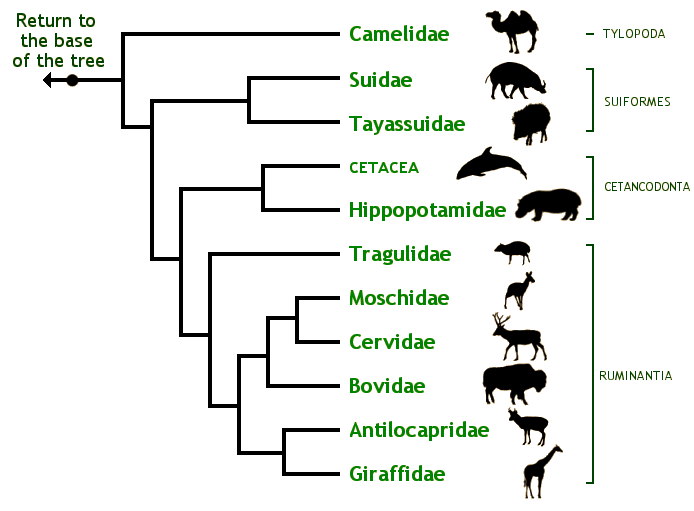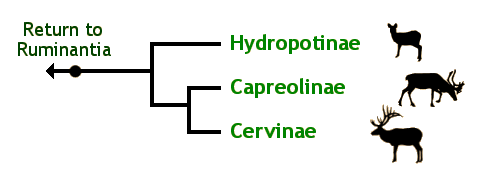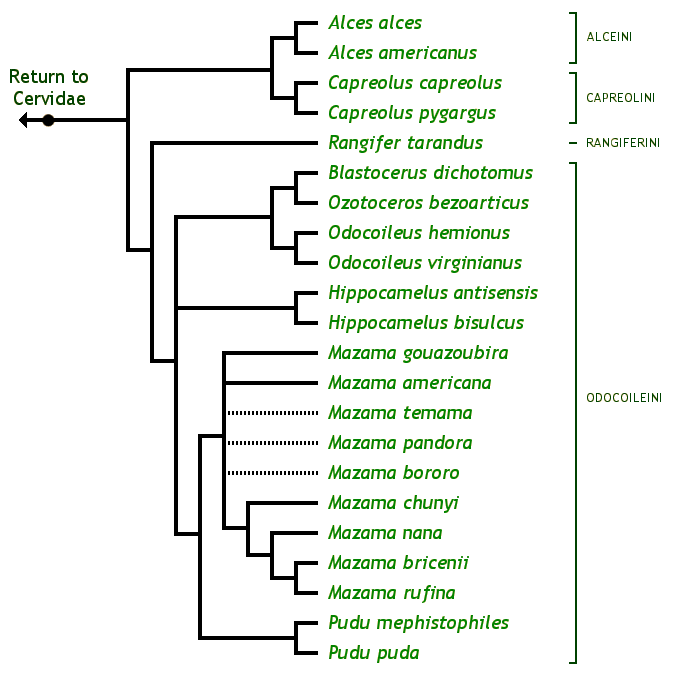Classification
Scientific name: Rangifer tarandus
Common name: Reindeer, or caribou, if wild in North America
The scientific name Rangifer tarandus comes from the
Old French rangier, meaning a reindeer, ferus, which is Latin for
wild and untamed, or also possibly from the Old Swedish ren, meaning a
reindeer, ferus (Latin) for wild, and tarandus (Latin) for animal
of the northern countries.10
The common name "reindeer" originated from the Old Norse
hreindryi, with the word hreinn being another name for horned animal,
plus the word dyr, meaning deer, before the year 1400. The name
"caribou"
is French, and comes from the words "Mi'kmaq qualipu" meaning “snow shoveler,”
referring to its habit of pawing through the snow for food.7
Complete Classification
The complete classification of Rangifer tarandus is listed below, with examples of the attributes that place it into each taxonomic division.
|
Domain |
Eukarya |
Cells contain
membrane-bound nucleus with DNA and organelles |
|
Kingdom |
Animalia |
Multicellular;
heterotrophic; lack cell walls; motile at some time in development |
|
Phylum |
Chordata |
Bilaterally
symmetrical; tripoblastic; cephalized; complete
digestive tract;
notochord; dorsal nerve
cord; endostyle; pharyngeal pouches;
post-anal tail; all of
these present at some time in development |
|
Class |
Mammalia |
Three middle ear bones;
hair; milk production by mammary glands6 |
|
Order |
Artiodactyla |
Even-toed ungulates;
weight held by third and fourth toes; domesticated; astragalus
bone with double-pulley
structure;
canines small or absent; low and high-crowned molars10 |
|
Suborder |
Ruminantia |
Specialized digestive
tract; four-chambered
stomach; teeth with crescent-shaped ridges;
cannon bone in foot; navicular and cuboid
bones fused; third and fourth digits well-developed, with the second and
fifth vestigial10 |
|
Infraorder |
Pecora |
Advanced ruminant
stomach; cranial appendages (horns)10 |
|
Family |
Cervidae |
Antlers; selenodont
cheek teeth; absent upper incisors with three incisors on each side of
bottom jaw joined by a canine; four toes
on each foot with lateral toes small and
not touching the ground; cannon
bone; postorbital bar; weight borne on third and fourth digits, space
between nasal, lacrimal, and frontal; five tarsals;
four-chambered
stomach8 |
|
Subfamily |
Capreolinae |
Telemetacarpal foot
structure; second and fifth metacarpals present as distal splinter of
bone; pedal glands in hind legs and tarsal glands
present; pause between when antlers are shed and a new pair grows10 |
|
Genus |
Rangifer |
Referred to as reindeer
or caribou; prevalent in
Arctic tundra regions of Eurasia, as well as
North America; both males and females have antlers- a characteristic of
the species (see
Home
for more general characteristics)10 |
|
Species |
Rangifer tarandus |
The only species of
genus Rangifer (see above) |
The following phylogenetic trees show the Order Artiodactyla to demonstrate related even-toed ungulate species to Rangifer tarandus, as well as a tree showing the Family Cervidae to indicate its closest relatives.
© Brent Huffman, www.ultimateungulate.com
The
above tree is based on morphological data from examination of fossils, but
recently the family Cetacea, which contains the whales and dolphins, have been
added to the Artiodactyla based upon molecular evidence comparing DNA sequences.
The DNA of whales was found to be very closely related to hippos, and
hippos are grouped under the order Artiodactyla, containing the ruminants under
which Rangifer tarandus is classified. Researchers also tracked the movement of
transposons called SINE's in the genome and found that they inserted themselves
at the same point in ruminant, whales, and hippos. This led
to grouping of the
Cetaceans under the Order Artiodactyla, and some now call it Cetartiodactyla.
10
Cervidae Family Tree
Cervidae first appeared as fossils in the early Miocene of
Asia, and then expanded to occupy many different niches. During the Miocene Era,
many migrated to North America where they expanded into the Nearctic region, and
then during the Pleistocene Era, crossed to South America.
All members of this family except one species possess
antlers composed
entirely of bone, characteristic only to this family. Evidence for structure of the above phylogenetic tree is also based upon
the fossil record and distinguishing morphological characteristics.10
Subfamily Capreolinae
European elk, American moose, Marsh deer, European and Siberian roe deer, Brockets, Mule deer, White-tailed deer, Pampas deer, Northern pudu, and Reindeer/Caribou.
Subfamily Cervinae
Axis deer, Calamian deer, Kuh's deer, Hog deer, Red deer, Japanese deer, American elk, Tufted deer, Milu, Muntjacs, Thamin, and Swamp deer.
Subfamily Hydropotinae
Chinese Water Deer
© Brent Huffman, www.ultimateungulate.com
Check out these pages below to learn about some of Rangifer tarandus's closest relatives:
Interested in where reindeer are found? Check out their habitat next!


